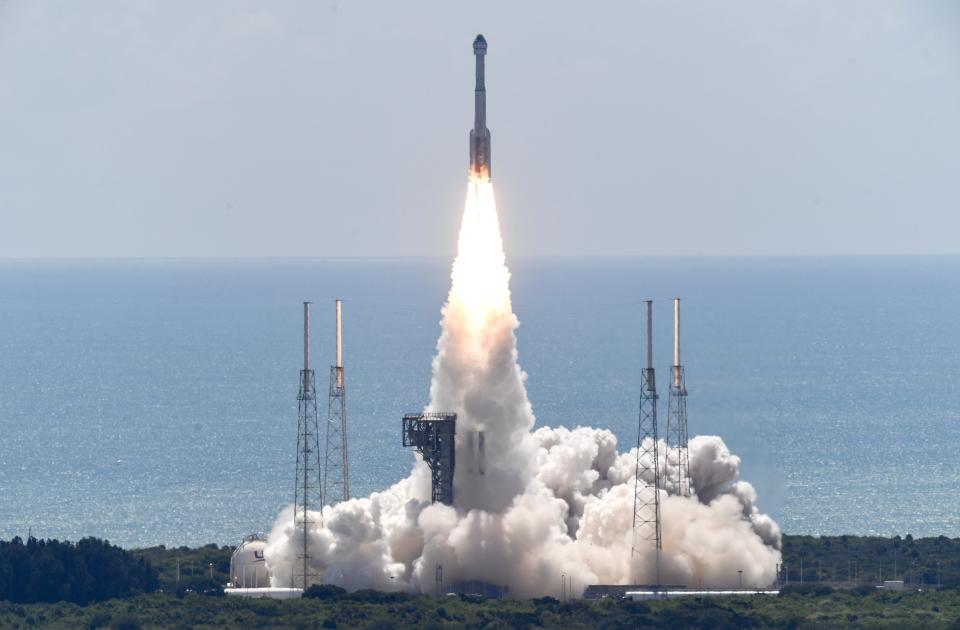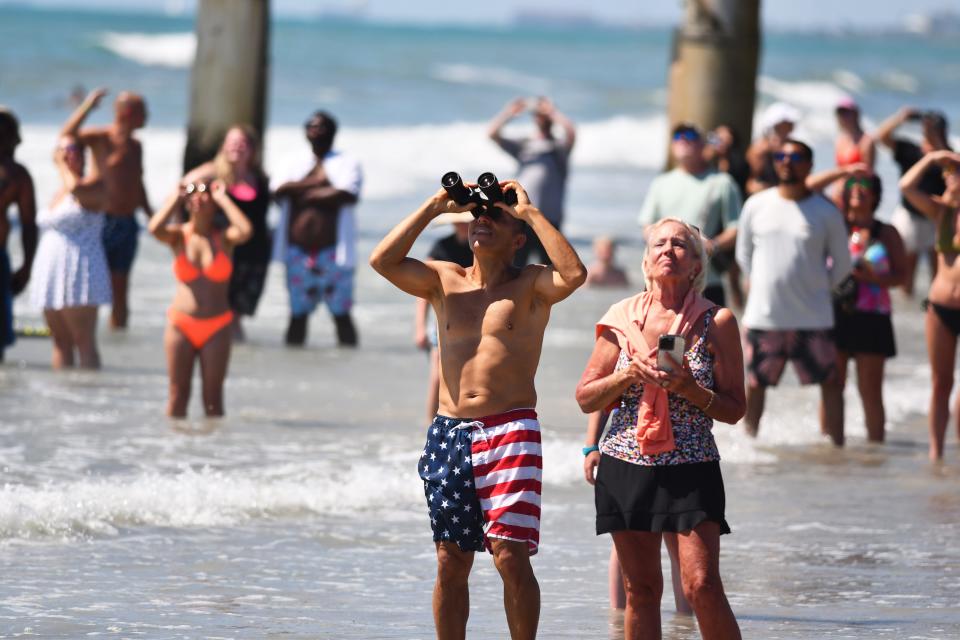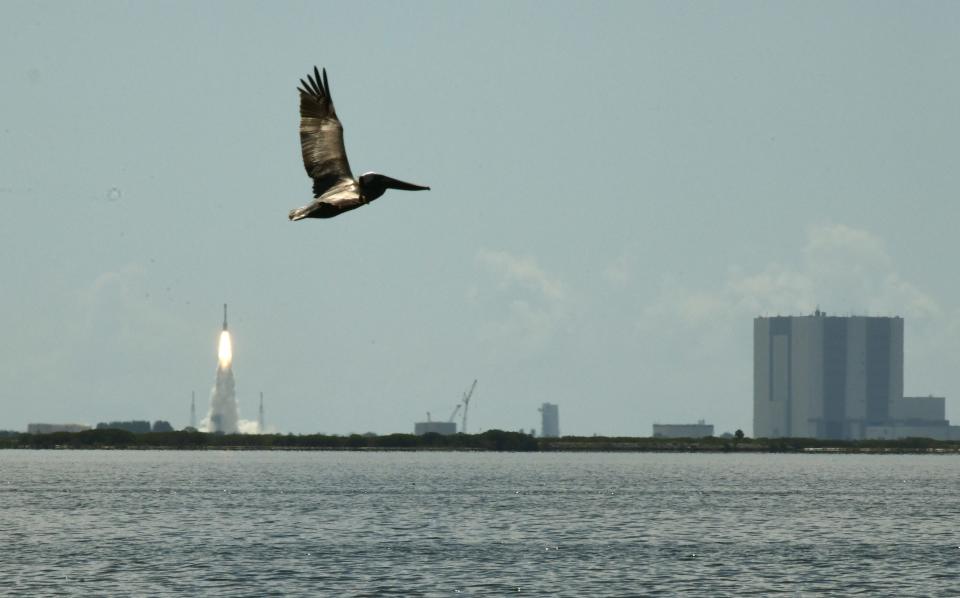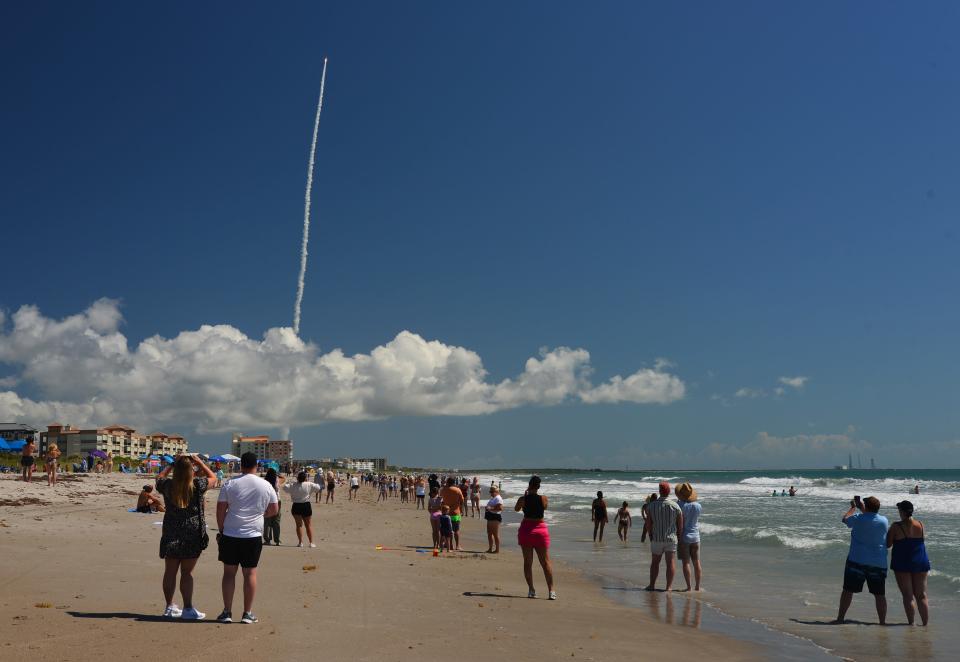'A new chapter': Boeing Starliner sends two NASA astronauts into orbit on way to ISS
- Oops!Something went wrong.Please try again later.
- Oops!Something went wrong.Please try again later.
Beneath a backdrop of scattered puffy clouds, NASA astronauts Butch Wilmore and Suni Williams soared into the history books Wednesday morning by taking Boeing's Starliner spacecraft on its maiden crewed mission.
Delayed by two previous scrubs, the historic Starliner launch finally occurred at 10:52 a.m. EDT. Wilmore and Williams lifted off from Launch Complex 41 at Cape Canaveral Space Force Station atop a United Launch Alliance Atlas V rocket.
After launch and a roughly 25-hour journey, NASA officials expect the Starliner — named Calypso in honor of explorer Jacques Cousteau's ship — to autonomously dock with the International Space Station about 12:15 p.m. Thursday.
Cape Canaveral: Is there a launch today? Upcoming SpaceX, NASA, ULA rocket launch schedule in Florida
“Two bold NASA astronauts are well on their way on this historic first test flight of a brand-new spacecraft,” NASA Administrator Bill Nelson said in a post-launch press release.
“Boeing’s Starliner marks a new chapter of American exploration. Human spaceflight is a daring task — but that’s why it’s worth doing. It’s an exciting time for NASA, our commercial partners, and the future of exploration," Nelson said.
Wilmore and Williams plan to spend about a week aboard the orbiting outpost, then return to New Mexico via parachutes inside America's newest crewed spacecraft.
Regarding Starliner, Nelson told reporters the duo is "going to test this thing from izzard to gizzard." Specifically, ULA reported the astronauts will assess an array of attributes aboard Starliner, including performance of crew equipment, suits and seats, spacecraft thrusters for manual abort scenarios, communication checkouts, manual and automated navigation, and life support systems, ULA reported.

“The principal provider of humans and logistics would be SpaceX at this point. Soyuz and Progress (Russia’s expendable cargo spacecraft) are still active. But having a set of redundancy within the United States, I would consider almost mandatory,” said retired NASA astronaut Fred Gregory, who logged more than 455 hours in space on three shuttle missions (STS-51B in 1985, STS-33 in 1989 and STS-44 in 1991).
Gregory — who served as NASA Deputy Administrator from 2002 to 2005 — told FLORIDA TODAY “redundancy is always highest priority” in terms of space travel and potential failure. He said he relates with Wilmore and Williams on a professional level, though he was working in Washington, D.C., when they were first selected as astronauts.
“Suni, as an example, was a helicopter pilot who went through tests while in school. I did the same thing. I went to the Naval Test Pilot School as a helicopter pilot,” Gregory said.

“But I also did fixed-wing — and Butch did that at the Navy Test Pilot School. So even though I may not know them personally, I know what they went through, the experiences they had, and the preparation for this,” he said.
“And I certainly consider them most highly qualified to do this,” he said.
Wednesday's groundbreaking mission marked the 100th flight of an Atlas V, ULA officials reported.
"The names of Wilmore and Williams now join Glenn, Carpenter, Schirra and Cooper as American astronauts to launch into space atop Atlas rockets from Cape Canaveral," a ULA blog post said.

The capsule is carrying about 759 pounds of cargo, including food, clothing, exercise gear, medical supplies, photo and media equipment, vehicle supplies and tools, NASA Commercial Crew officials reported.
“Flying crew on Starliner represents over a decade of work by the Commercial Crew Program and our partners at Boeing and ULA,” program manager Steve Stich said in a post-launch press release.
“For many of us, this is a career-defining moment bringing on a new crew transportation capability for our agency and our nation. We are going to take it one step at a time, putting Starliner through its paces, and remaining vigilant until Butch and Suni safely touch down back on Earth at the conclusion of this test flight," Stich said.

Prior to Wednesday's launch, Starliner flew two uncrewed orbital flights — including a test to and from the ISS — along with a pad abort demonstration, NASA reported.
For the latest news and launch schedule from Cape Canaveral Space Force Station and NASA's Kennedy Space Center, visit floridatoday.com/space.
Rick Neale is a Space Reporter at FLORIDA TODAY. Contact Neale at Rneale@floridatoday.com. Twitter/X: @RickNeale1
This article originally appeared on Florida Today: Boeing Starliner lifts NASA astronauts into space for the first time

